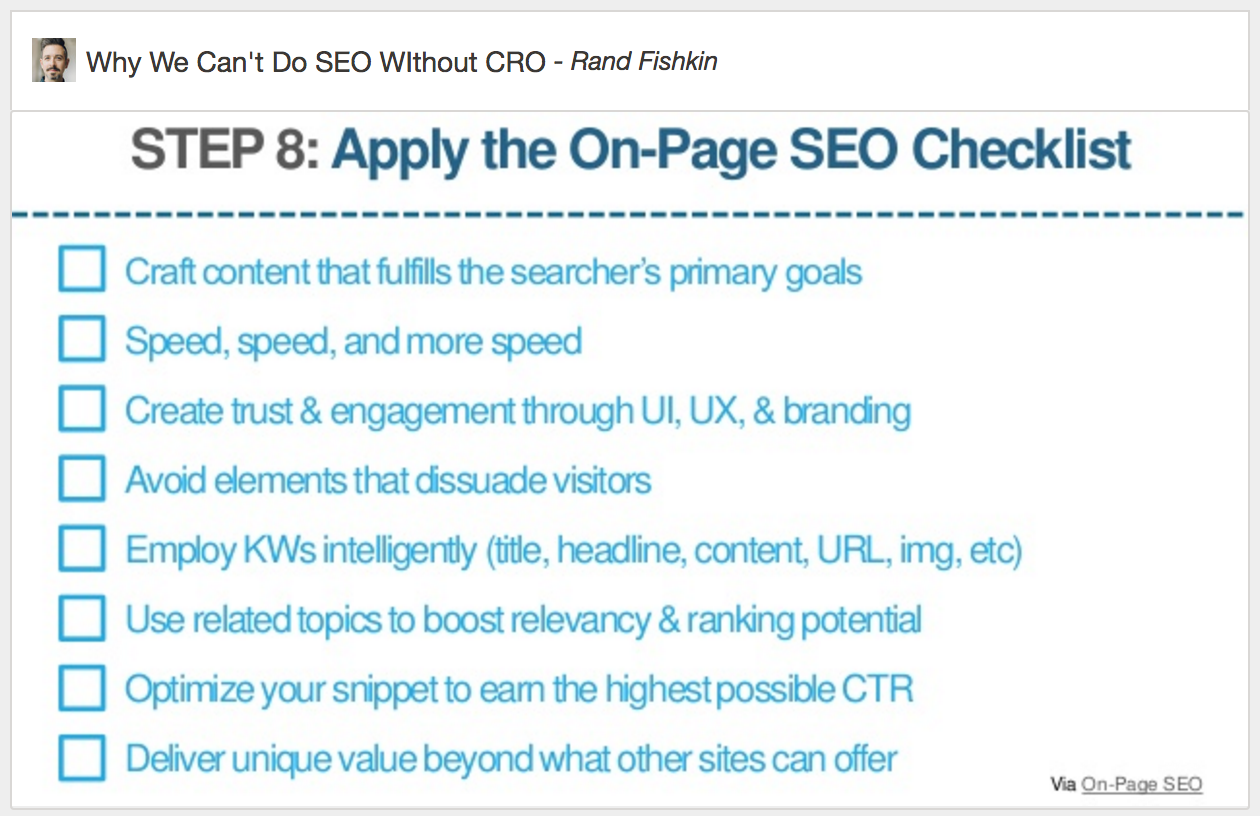Note from Millie:
This is the third post in my five-part CTA Series, where I’m recapping the most impactful takeaways from the 2017 Unbounce CTA Conference.
One of the best things about this conference was how I learned valuable marketing lessons from people in fields totally unrelated to what I do every day.
Today’s post definitely falls into that. SEO is not my forte … but after listening to Rand Fishkin talk, I could see that Google’s mission isn’t far off from our own. We want to solve our customer’s problems — and so does Google.
On that note …

The Only Way to Win the Marketing Game Today Is to Help Your Prospects Win
Rand Fishkin is the founder of Moz, co-founder of Inbound.org, and one of the most prominent voices in SEO (search engine optimization). In his dynamic talk at CTA Conf, he shared a controversial belief he holds: SEO can’t work without CRO (conversion rate optimization).
As a marketer, you’re probably already familiar with CRO. In case you’re not, here’s a brief definition:
CRO is the practice of using analytics and customer feedback to improve the performance of a website or webpage.
You might be wondering why the partnership between SEO and CRO is so important that I could write this blog post for you.
Here is the answer in a nutshell: To be successful in SEO or CRO today, you have to focus first and foremost on being genuinely helpful to your customers.
The Evolution of Google
Google’s algorithm is a constant work in progress, but one thing has never changed — solving the user’s search query is the ultimate measure of success.
That means providing the fastest and most accurate answer.
If you want to rank high in the SERPs (search engine results pages), you have to solve the visitor’s problem.
Interestingly, Google is now providing a snippet of the first few lines of the most relevant webpage on the search page itself, so users don’t even have to click to visit the website to get the answer.

You might think this is a bad thing for your business, because the user doesn’t have to click and go to your website to solve their problem. Actually, though, a lot of people still click through. More importantly, this paints your content — and your company or solution — as highly relevant to the user.
The Current State of Google Search
Now Google expects even more from your marketing content. Not only do you have to provide the fastest and most accurate answer to solve the visitor’s problem, you have to take them all the way through their issue.
Solve one problem … but then solve the next, and the next, so the visitor doesn’t have to go back to Google at all.
SEO is no longer about backlinks and keywords. It’s now a long-term play.
Rand gave us some solid advice on exactly how to do this.
Step 1: Establish your primary keyword target.
Step 2: Expand that keyword with related phrases that share the same searcher intent.
Step 3: Add in keywords around expanded searcher intent.
Step 4: Visit your high-ranking competition and find out what tasks they’re helping searchers solve.
Step 5: Survey a small group of your customers and followers and ask what they want and what they are (or would be) searching for.
Step 6: Use the survey answers and curate a list of problems your content can solve.
Step 7: Create content to meet those needs, and make it easy to access other content that meets related needs.
Step 8: Apply the On-Page SEO Checklist.

Step 9: Take a note from CRO pros and test your page for usability.
Step 10: Launch, learn and iterate.
When CRO and SEO Go Head to Head
Sometimes CRO and SEO are in direct conflict. To improve your on-page conversion rates, for example, you might add a pop-up asking people to request a demo. A visitor coming from search results, just looking to solve a problem, might be turned off by that and click the back button.
Even if the pop-up improved conversion rates, it came at the cost of SEO.
Rand suggested a solution: long-term thinking.
Trying to convert people right out of the gate might not be the smartest move. Many businesses find that their best customers spent a lot of time on the website and came back multiple times before they bought. Look at your own analytics to determine if this is true for you.
If that is the case for you, consider solving the visitor’s problem first, then find ways to benefit from the trust you’ve gained. Focus more on solving the visitor’s problems (note the plural!) and less on a quick conversion, and you may find that both your SEO and your sales numbers improve.
--
Read Part 1, How Popeye Single-handedly Saved the Spinach Industry.
Read Part 2, Speaking Your Customer’s Language in Your Marketing Campaigns.